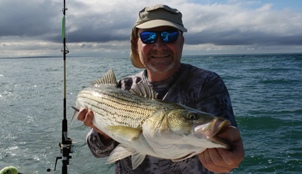Casting and Drifting Eels

As with all of the articles I have written, my goal is to help teach some skills, to the average boater/fisherman, to help achieve some success in a safe manner. I have covered basic fish biology and fish movement as well as wire line trolling and jigging techniques. This month’s topic is timely as eel fishing starts to really take hold in July as the fish periodically move off the reefs and spend time feeding in rocky areas of Buzzards Bay, the Vineyard and the Elizabeth Islands. Casting eels into the beach is the way I ‘pull a rabbit out of my hat’ during tough summer trips where trolling just doesn’t produce.
This article will just cover only spinning rod techniques. If you are one of those old school fishermen, who use conventional tackle to cast, you probably don’t need to read any further as you already know the drill. So, I guess the first question is: what do I use for tackle? The answer is very simple. Any spinning rods will suffice. I prefer my 7’ Daiwa Eliminator Boat, spinning rods with Daiwa BG60 reels loaded with 25# test team fish high impact, coral Mono. But, any spinning rod with any 15#+ line will work. For hooks, you can ‘cheap out’ and use Eagle Claw 6/0 all purpose bait hooks, which are $12 per 100 or, you can use the Gamigazu 6/0 or 7/0 Octopus Hooks, which are much better but more expensive. Circle hooks are not preferable. Circles make it hard to hook an eel in the dark and they often end up gill hooking the small bass. This ends up being a fish that you can’t release or it will die. We never want to waste stripers or any fish, for that matter. For leaders, these are also very simple. Use a small swivel and any 40# mono or, if you so inclined as I, use 50# Team Fish Flouro-carbon. Flouro is tougher and the Team fish line is softer and snells up much better than the SeaGar brand. Use a 24” leader for casting & retrieving into the beach and use a 30-32” leader for drifting eels. This longer leader giver you space to put a rubber core above the swivel and allows the eel to drift a bit flatter than a short leader.
Always keep your eels in a black bucket with lots of holes drilled in it and a brick in the bottom. Make sure this bucket is kept off the bottom and in an area with water movement so they get plenty of oxygen. Why black? Because, eels, just like bass and all other fish, take on the color of their surroundings. You want to use black eels at night. If you are day fishing, keep a few pounds in a white bucket. Before going fishing, take a small cooler and put a 1” layer of ice cubes on the bottom and then put the eels on the ice. Do not put the ice on the eels or you will kill them. If you put the eels on the ice, they will basically go to sleep and wake up after you hook‘em and splash’em. Make sure to move them around in the ice every hour or so just to keep them on top of the ice.
Drifting techniques: This technique is a bit simpler than casting eels into the beach. I perfected this technique from the ’98-’04 period when we had loads of 15-40# bass on all of the mussel beds at Squibnocket and between the Vineyard and Noman’s. The first thing you need is a place that is holding a few fish. Fish on the ledges and humps and look to get a drift of .5 – 1.1 knots. Once your drift goes over .08 knots, consider adding a 3/8 oz rubber core to keep the eel down there where he needs to be eaten. Once you get a bit of experience with this technique, you can easily use 4 – 5 rods at once always casting up-drift and just letting the eel swim. Watch the lined closely and keep the ells separated. They like to school and will wrap your lines together. Another secret is to keep one already eel hooked up on the ice. Once you get a fish on, reel it half way to the boat, put the rod in the holder and lob that ells behind the fish that’s hooked up to get his buddy that may be following. This is how you manufacture fish and take 15 when others take 7 or 8.
Casting into the beach: This technique is a bit more complicated and requires more seamanship and boat handling skills. I suggest you try this out in the early morning when you have a bit of ambient light before doing is on a dark night. If there is a big sea on and/or strong wind, be extra conscious of getting driven onto the rocks or beach. I have never let it happen but I’m sure it’s a one way trip. Sometime, if I know the fish in a spot, I will anchor up and just stay on them. They turn on, they turn off, we cast, we rest. But, after 4 or 5 hrs or so, we usually have 15 decent fish and a few throw backs. A key to this technique is to keep the rod tip high and stop reeling every time the eel shakes. He may get eaten!
Capt. Todd MacGregor
Fairhaven, MA


